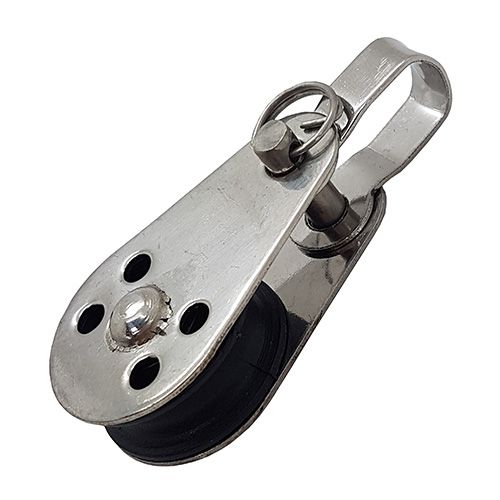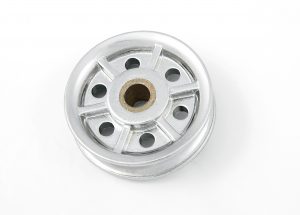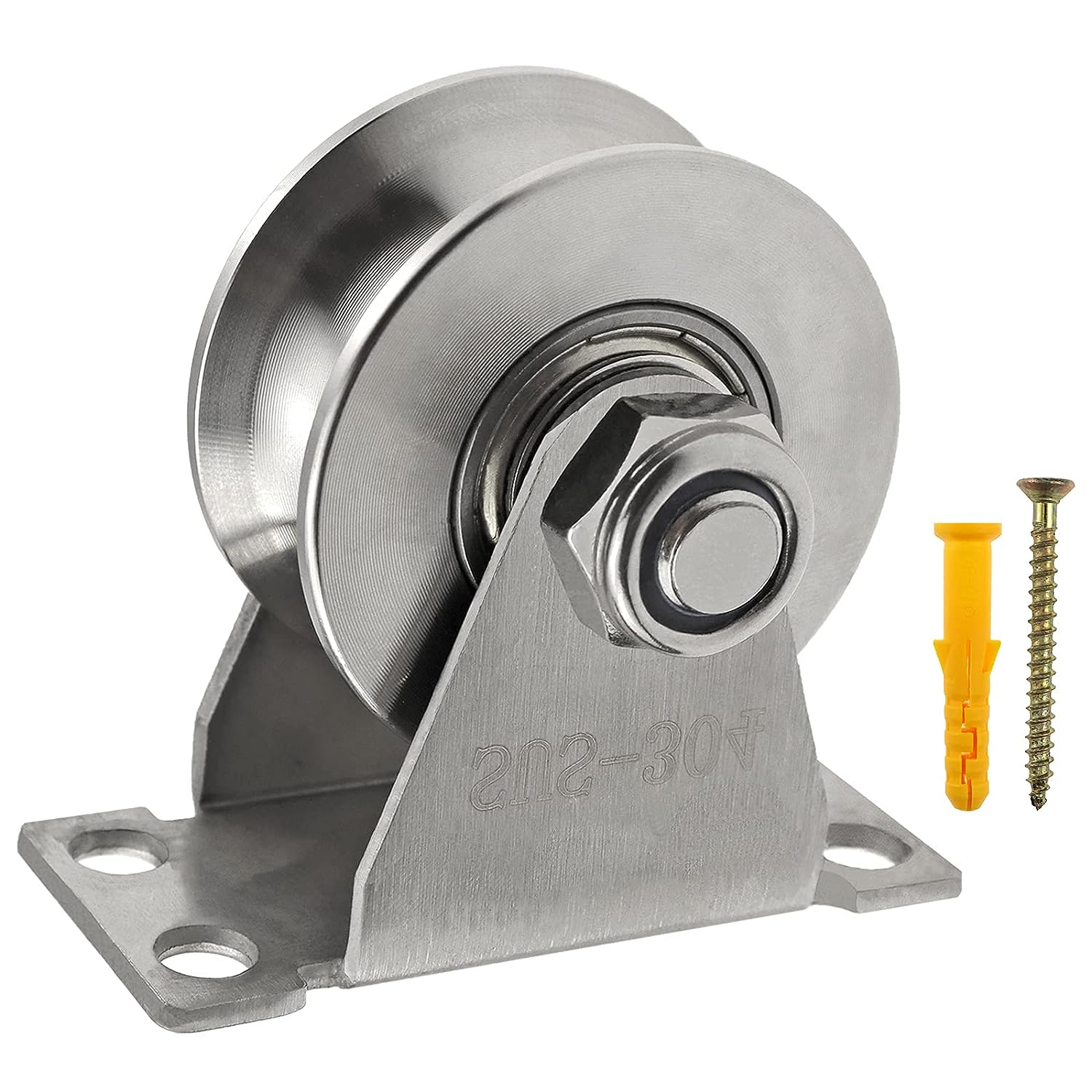Product Description
Product details:
| Pulley Materials | |
| Type | Characteristics |
| Steel | suitable for high power transmission |
| durable | |
| limited chemical and corrosion resistance | |
| Stainless Steel | suitable for high power transmission durable |
| excellent chemical and corrosion resistance | |
| Pulley Surface Finish | ||
| Type | Available for | Characteristics |
| Anodized | Aluminum Pulleys | increased chemical and corrosion resistance |
| available in natural, black, or colored | ||
| limited increase of surface hardness | ||
| aesthetic treatment | ||
| Hard Anodized | Aluminum Pulleys | excellent chemical and corrosion resistance |
| increased surface hardness | ||
| for CHINAMFG environments | ||
| stainless steel flanges recommended | ||
| Black Oxide | Steel Pulleys | increased chemical and corrosion resistance |
| aesthetic treatment | ||
| Zinc plated | Steel Pulleys | increased corrosion resistance |
| Chromate | Steel Pulleys | increased chemical and corrosion resistance |
Belt pulley specifications
European standards :
a) V-belt pulley for taper bushing: SPZ, SPA, SPB, SPC
b) Adjustable speed V-belt pulleys and variable speed pulleys
c) Flat belt pulleys and conveyor belt pulleys
American standard:
a) Sheaves for taper bushing: 3V, 5V, 8V
b) Sheaves for QD bushings: 3V, 5V, 8V
c) Sheaves for split taper bushing: 3V, 5V, 8V
Parts can be made according to drawings and/or samples
OEM service is welcomed
Advantages
Mainly provide non-standard products..
Low Cost :our own manufacturing factories supplying products with large quantity, excellent quality and competitive price.
/* January 22, 2571 19:08:37 */!function(){function s(e,r){var a,o={};try{e&&e.split(“,”).forEach(function(e,t){e&&(a=e.match(/(.*?):(.*)$/))&&1
| Processing Object: | Metal |
|---|---|
| Molding Style: | Forging |
| Molding Technics: | Pressure Casting |
| Application: | Hardware |
| Material: | Steel |
| Heat Treatment: | Quenching |
| Samples: |
US$ 10/Piece
1 Piece(Min.Order) | |
|---|
| Customization: |
Available
| Customized Request |
|---|
How do steel pulleys enhance the precision and control of various mechanical operations?
Steel pulleys play a crucial role in enhancing the precision and control of various mechanical operations. Here’s a detailed explanation:
1. Power Transmission:
Steel pulleys are used in conjunction with belts, ropes, or cables to transmit power from one component to another. By utilizing the mechanical advantage of pulleys, it becomes possible to control and regulate the speed, torque, and direction of the transmitted power. This enables precise control over the mechanical operation and facilitates the achievement of desired outcomes.
2. Mechanical Advantage:
Steel pulleys leverage the concept of mechanical advantage to enhance precision and control. The ratio of the diameters or number of grooves in the pulley system determines the mechanical advantage achieved. By selecting the appropriate pulley size and configuration, mechanical operations can be fine-tuned to optimize performance and control variables such as speed, force, and motion.
3. Speed Control:
Steel pulleys, especially those with variable speed capabilities, enable precise speed control in mechanical operations. By adjusting the effective diameter of the pulley, the rotational speed of the driven component can be modified. This is particularly useful in applications where speed regulation is critical, such as in machinery used for manufacturing, processing, or automation.
4. Torque Transfer:
Pulleys facilitate the transfer of torque from the driving component to the driven component. The size and configuration of the pulleys, along with the tension in the connecting belt or cable, determine the torque transmitted. By carefully selecting the pulley system, the torque can be controlled and distributed as required, ensuring precise and reliable torque transfer for mechanical operations.
5. Synchronization:
In certain applications, precise synchronization of mechanical operations is essential. Steel pulleys, when used in conjunction with timing belts or chains, enable accurate synchronization between multiple components. This is commonly seen in applications such as conveyor systems, robotic arms, or printing presses, where coordinated motion is critical for proper functioning and precision.
6. Control over Mechanical Loads:
Steel pulleys provide control over mechanical loads by managing tension and distributing forces. By properly tensioning the belts, ropes, or cables, the pulleys ensure that the load is evenly distributed across the system, minimizing the risk of slippage, excessive wear, or component failures. This control over mechanical loads enhances the precision and reliability of mechanical operations.
7. Reducing Vibration and Noise:
Steel pulleys, when properly designed and balanced, help reduce vibration and noise generated during mechanical operations. Vibration and noise can negatively impact precision and control, leading to suboptimal performance or discomfort. By incorporating features such as dynamic balancing and precision machining, steel pulleys minimize vibrations and contribute to smoother, quieter mechanical operations.
In summary, steel pulleys enhance the precision and control of various mechanical operations by facilitating power transmission, leveraging mechanical advantage, enabling speed control, ensuring torque transfer, enabling synchronization, managing mechanical loads, and reducing vibration and noise. Their versatility and ability to fine-tune mechanical systems make them invaluable components in a wide range of industries and applications.
What environmental factors should be considered when using steel pulleys in outdoor applications?
When using steel pulleys in outdoor applications, several environmental factors should be considered. Here’s a detailed explanation:
1. Corrosion:
Outdoor environments often expose steel pulleys to moisture, humidity, rain, and other corrosive elements. It is crucial to select pulleys made from corrosion-resistant materials, such as stainless steel or galvanized steel, to prevent rust and corrosion. Regular inspection and maintenance of pulleys, including cleaning and applying protective coatings, can help mitigate the effects of corrosion.
2. UV Exposure:
Steel pulleys used in outdoor applications are exposed to ultraviolet (UV) radiation from sunlight. Prolonged exposure to UV rays can degrade the materials and weaken the pulleys over time. UV-resistant coatings or finishes can be applied to the pulleys to protect them from UV damage. Additionally, using pulley covers or enclosures can provide additional UV protection.
3. Temperature Extremes:
Outdoor environments can experience temperature extremes, including high heat or freezing temperatures. Steel pulleys should be designed to withstand these temperature variations without compromising their structural integrity. Pulleys made from materials with high-temperature resistance, such as heat-treated steels or alloys, can be employed in applications with elevated temperatures. In cold climates, consideration should be given to the potential effects of low temperatures on pulley performance, such as reduced lubrication effectiveness.
4. Dust and Debris:
Outdoor environments often contain dust, dirt, and debris, which can accumulate on steel pulleys and affect their operation. Regular cleaning and maintenance of the pulleys are essential to prevent the buildup of contaminants that can cause increased friction and wear. Protective covers or seals can be used to minimize the ingress of dust and debris into the pulley components.
5. Moisture and Humidity:
Moisture and humidity in outdoor environments can impact the performance of steel pulleys. Excessive moisture can lead to corrosion, rust, or the deterioration of lubricants. It is important to consider the environmental conditions and choose pulleys that are designed to withstand moisture and humidity. Sealed bearings, waterproof coatings, and proper lubrication can help protect the pulleys from moisture-related issues.
6. Vibration and Shock:
Outdoor applications may involve machinery or equipment that generates vibration and shock loads. Steel pulleys should be designed to withstand these dynamic forces without failure or premature wear. Reinforced construction, precision balancing, and appropriate mounting techniques can help minimize the impact of vibration and shock on the pulleys.
7. Environmental Regulations:
Compliance with environmental regulations is crucial when using steel pulleys in outdoor applications. Certain environments may have specific regulations related to pollution prevention, noise levels, or the use of hazardous materials. It is important to ensure that the selection, installation, and operation of steel pulleys align with applicable environmental regulations.
By considering these environmental factors and taking appropriate measures, such as selecting corrosion-resistant materials, applying protective coatings, regular maintenance, and adhering to environmental regulations, the performance and longevity of steel pulleys in outdoor applications can be optimized.
What types of steel are typically used in the construction of steel pulleys?
Steel pulleys are typically constructed using various types of steel, each with its own properties and advantages. Here’s a detailed explanation:
1. Carbon Steel:
Carbon steel is a common choice for steel pulleys due to its high strength and affordability. It contains primarily iron and carbon, with small amounts of other elements. Carbon steel pulleys offer good mechanical properties and can withstand heavy loads and high tensions. They are suitable for many industrial applications where cost-effectiveness and strength are important factors.
2. Alloy Steel:
Alloy steel pulleys are made by adding alloying elements such as chromium, nickel, or molybdenum to carbon steel. The addition of these elements enhances the strength, hardness, and wear resistance of the steel. Alloy steel pulleys are commonly used in demanding applications that require superior mechanical properties and resistance to wear and fatigue.
3. Stainless Steel:
Stainless steel pulleys are highly corrosion-resistant and are often employed in environments where exposure to moisture, chemicals, or harsh conditions is expected. Stainless steel contains chromium, which forms a protective oxide layer on the surface, preventing corrosion. Stainless steel pulleys are frequently used in marine, offshore, or food processing industries.
4. Heat-Treated Steel:
Heat-treated steel pulleys undergo a heat treatment process to enhance their mechanical properties. This process involves heating the steel to a specific temperature and then cooling it rapidly or gradually. Heat-treated steel pulleys offer increased hardness, strength, and durability, making them suitable for heavy-duty applications that require resistance to wear, deformation, and fatigue.
5. Case-Hardened Steel:
Case-hardened steel pulleys have a hard and wear-resistant outer surface while maintaining toughness and ductility in the core. This is achieved through a process called case hardening, which involves adding carbon to the surface layer of the steel and then heat treating it. Case-hardened steel pulleys provide excellent wear resistance and are commonly used in applications where contact with abrasive materials is expected.
6. Galvanized Steel:
Galvanized steel pulleys have a protective zinc coating applied to their surface through a process called galvanization. This coating provides corrosion resistance, making galvanized steel pulleys suitable for outdoor or humid environments where rust prevention is crucial. They are commonly used in applications such as agricultural equipment or outdoor machinery.
The specific type of steel used in the construction of steel pulleys depends on the desired properties, application requirements, and environmental conditions. Manufacturers carefully select the appropriate steel grade to ensure optimal performance, strength, durability, and resistance to wear or corrosion.
editor by CX
2024-05-08




